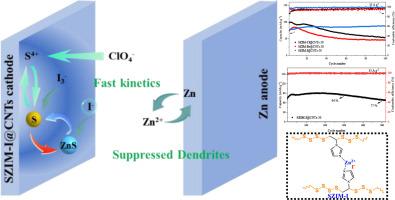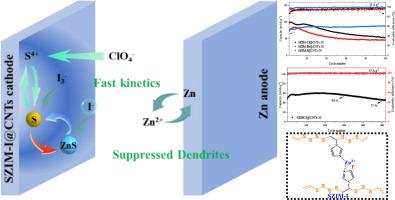Halide ions-contained polysulfides as cathode materials for aqueous zinc-sulfur batteries with improved cycling performance
IF 5.6
3区 材料科学
Q1 ELECTROCHEMISTRY
引用次数: 0
Abstract
Organic sulfur-based cathode materials for aqueous zinc-sulfur batteries have garnered significant attention, however, insufficient sulfur content, and sluggish redox kinetics hinder their application. To overcome these challenges, polysulfides SZIM-X (X = Cl, Br, I) were synthesized via inverse vulcanization of sulfur with ZnX2 coordinated 1-vinylimidazole. Carbon nanotubes composited SZIM-X (SZIM-X@CNTs) featuring imidazole-Zn2+ coordination bonds exhibited high sulfur content (>64 wt%) and exceptional volume-change tolerance. The SZIM-Cl@CNTs-50 cathode delivered a high capacity of 690 mAh g-1 at 0.5 A g-1 with 53% retention after 100 cycles (35 A g-1). Similarly, the SZIM-Br@CNTs-50 cathode exhibited a capacity of 356 mAh g-1 with 55% retention after 100 cycles. In contrast, the SZIM-I@CNTs-50 achieved 420 mAh g-1 at 0.5 A g-1 with 77% retention even after 500 cycles. Ex situ XPS and in situ Raman analyses confirmed highly reversible redox transitions between S2-↔S0↔S4+ and I-↔I3- in Zn(ClO4)2 electrolyte. The findings provided a strategy and insight for practical applications of organic electrode materials in zinc-sulfur batteries.


含卤化物离子的多硫化物作为提高循环性能的锌硫水电池正极材料
有机硫基正极材料用于含水锌硫电池已经引起了广泛的关注,然而,硫含量不足和氧化还原动力学缓慢阻碍了它们的应用。为了克服这些挑战,通过ZnX2配位的1-乙烯基咪唑与硫的反硫化合成了多硫化物SZIM-X (X = Cl, Br, I)。含有咪唑- zn2 +配位键的碳纳米管复合材料szm - x (SZIM-X@CNTs)具有高硫含量(>64 wt%)和优异的容变能力。SZIM-Cl@CNTs-50阴极在0.5 a g-1下提供690 mAh g-1的高容量,在100次循环(35 a g-1)后保持53%。同样,SZIM-Br@CNTs-50阴极在100次循环后的容量为356 mAh g-1,保留率为55%。相比之下,SZIM-I@CNTs-50在0.5 A g-1下达到420 mAh g-1,即使在500次循环后仍保持77%。迁地XPS和原位拉曼分析证实了Zn(ClO4)2电解质中S2-↔S0↔S4+和I-↔I3-之间的高度可逆氧化还原转变。研究结果为有机电极材料在锌硫电池中的实际应用提供了策略和见解。
本文章由计算机程序翻译,如有差异,请以英文原文为准。
求助全文
约1分钟内获得全文
求助全文
来源期刊

Electrochimica Acta
工程技术-电化学
CiteScore
11.30
自引率
6.10%
发文量
1634
审稿时长
41 days
期刊介绍:
Electrochimica Acta is an international journal. It is intended for the publication of both original work and reviews in the field of electrochemistry. Electrochemistry should be interpreted to mean any of the research fields covered by the Divisions of the International Society of Electrochemistry listed below, as well as emerging scientific domains covered by ISE New Topics Committee.
 求助内容:
求助内容: 应助结果提醒方式:
应助结果提醒方式:


